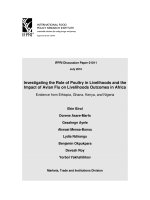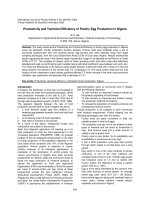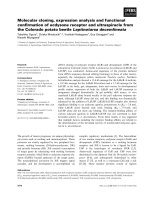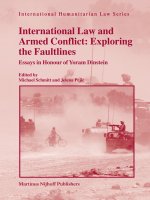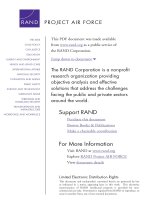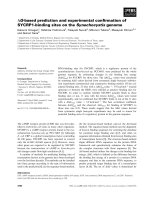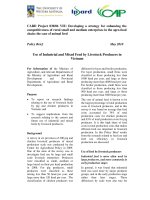Screening of Bacillus strains as potential probiotics and subsequent confirmation of the in vivo effectiveness of Bacillus subtilis MA139 in pigs doc
Bạn đang xem bản rút gọn của tài liệu. Xem và tải ngay bản đầy đủ của tài liệu tại đây (186.65 KB, 8 trang )
Abstract A total of 124 samples were collected
from the intestine of broiler chickens, piglet faeces,
fermented foods, soils and Chinese herbs. More than
750 strains of aerobic, spore-forming bacteria were
isolated from these samples. The inhibitory activity
of these spore-forming strains against Escherichi-
a coli K88, E. coli K99, Salmonella typhimurium and
Staphylococcus aureus was assessed using a disc
plate diffusion assay. The six bacilli with the largest
inhibition zones against the four indicator bacteria
were chosen and assessed for their resistance to
unfavorable conditions within simulated gut envi-
ronments. The strain Bacillus subtilis MA139
showed full resistance to pH 2, 0.3% bile salts and
exhibited the highest antimicrobial activity. Based on
these results, B. subtilis MA139 was selected as a
potential probiotic and fed to piglets at concentrations
of 2.2 · 10
5
, 2.2 · 10
6
or 2.2 · 10
7
CFU/g of feed
during a 28-day feeding trial. A negative control
consisting of the basal diet with no additives and a
positive control consisting of the basal diet supple-
mented with 16 g/ton flavomycin were also included.
Ninety piglets between 35 and 40 days old were used
in the in vivo animal trials. B. subtilis MA139 en-
hanced daily gain (P = 0.10) and feed conversion
(P = 0.03) compared with the negative control. The
performance of pigs fed B. subtilis MA139 supple-
mented diets did not differ from that of pigs fed the
antibiotic diet. There was a significant increase in
Lactobacilli cell counts (P = 0.02) and a numerical
decrease in E. coli counts (P = 0.05) in the faecal
samples of pigs fed B. subtilis MA139 with
2.2 · 10
5
CFU/g of feed. The overall results of this
study show that the use of initial co-culture with
indicator pathogens, a disc plate diffusion assay and
simulated gut environment tolerance tests is one of
effective methods of screening Bacillus for probiotic
use and that B. subtilis MA139 is a promising alter-
native to antibiotics for use as a feed additive in piglet
diets.
Keywords Bacillus Æ Screening Æ Antimicrobial
activity Æ Stability Æ Piglets Æ Performance
Introduction
Due to concerns about residues in animal products
and the development of bacterial resistance to anti-
biotics, the potential exists for the implementation of
a complete ban of the use of antibiotics in animal
feed. As a consequence, the development of alterna-
tives to antibiotics is receiving considerable attention
(Turner et al. 2001). Probiotics are one potential
X. Guo Æ D. Li (&) Æ W. Lu Æ X. Piao Æ X. Chen
National Key Laboratory on Animal Nutrition, China
Agricultural University, No. 2. West Road
Yuanmingyuan, Beijing 100094, P.R. China
E-mail:
Tel.: +8610-62733588
Fax: +8610-62733688
Antonie van Leeuwenhoek (2006) 90:139–146
DOI 10.1007/s10482-006-9067-9
123
ORIGINAL PAPER
Screening of Bacillus strains as potential probiotics
and subsequent confirmation of the in vivo effectiveness
of Bacillus subtilis MA139 in pigs
Xiaohua Guo Æ Defa Li Æ Wenqing Lu Æ
Xiangshu Piao Æ Xiaoling Chen
Received: 13 December 2005 / Accepted: 3 March 2006 / Published online: 4 July 2006
Ó Springer Science+Business Media B.V. 2006
alternative. Probiotics have been defined as ‘‘live
microbial feed supplements that can benefit the host
by improving its intestinal balance’’ (Fuller 1989).
As living microorganisms, they produce no drug
resistance or drug residues (Kyriakis et al. 1999;
Scharek et al. 2005).
The most common microorganisms found in the
probiotic products currently available are lactic acid
bacteria, especially Lactobacillus and Bifidobacteri-
um species, which are resident microflora in the
gastrointestinal tract of most animals (Chang et al.
2001; Simpson et al. 2004). Bacillus species, a type
of exogenous spore-forming bacteria, are not nor-
mally found in the gastrointestinal tract but have also
been shown to be effective in keeping a favorable
balance of microflora in the gastrointestinal tract and
in improving animal performance (Zani et al. 1998;
Adami and Cavazzoni 1999; Kyriakis et al. 1999;
Alexopoulos et al. 2004; Kritas and Morrison 2005).
Generally, when a Bacillus is used as a probiotic, it is
used in the spore form and thus can be resistant to
unfavorable conditions arising during transit through
the gastrointestinal tract of animals. However, not all
strains of Bacillus are equally resistant to the envi-
ronment in the gastrointestinal tract and antimicrobial
activity varies between strains (Chang et al. 2001;
Dunne et al. 2001; O’Sullivan 2001). Therefore, the
selection of Bacillus strains for use as potential pro-
biotics could play a crucial role in increasing their
effectiveness as feed additives (Barbosa et al. 2005).
The objective of this study was to screen strains of
spore-forming bacteria used as probiotics and then
evaluate the strain of Bacillus showing the greatest
in vitro potential for its effectiveness in improving
piglet performance and faecal flora.
Materials and methods
Bacterial strains, growth media and initial
isolation of spore-formers
Four pathogens were used as indicator bacteria,
including Escherichia coli IVDC C83901, serotype
O8:K87, K88ac; E. coli IVDC C83529, serotype
O141:K99; Salmonella typhimurium IVDC C77-31
and Staphylococcus aureus IVDC C56005. The
indicator bacteria were purchased from the China
Veterinary Culture Collection Center (Beijing,
China). The bacteria were cultivated and incubated in
Nutrient Broth. All strains were stored in )80°C with
20% sterile glycerol until needed.
One hundred and twenty-four samples were col-
lected from the intestine of broiler chickens, piglet
faeces, fermented foods, soils and Chinese herbs.
About 2 g of each sample was individually cultured
in 5 ml of Mixed Nutrient broth (peptone, 5.0 g/l;
beef extract, 3.0 g/l; glucose, 5.0 g/l; yeast extract,
1.0 g/l; MgSO
4
Á 7H
2
O, 0.5 g/l, pH 6.8–7.0) inocu-
lated with all four of the indicator bacteria (about
10
6
CFU/ml each). The incubation was conducted in
50 ml test tubes placed on a rotary shaker
(n=250 rpm) at 37°C for 48 h. The Bacillus strains
subsequently screened for antimicrobial production
were isolated as the survivors of a treatment of cul-
tures for 15 min at 80°C by water bath.
The cultures were then cross-streaked in Mixed
Nutrient agar (Mixed Nutrient broth plus 1.5% agar)
in Petri dishes and grown at 37°C for 24 h. Individual
colonies of bacteria that appeared to be distinct and to
have grown from one cell were chosen to further
detect their antimicrobial activity.
Antimicrobial activity screening assay
The antimicrobial activity of the initially isolated
spore-formers was determined using a disc plate
diffusion assay conducted according to the methods
of Lyver et al. (1998). Pure isolates of spore-forming
bacteria (6 isolates per dish) were spotted with sterile
toothpicks on Mixed Nutrient agar (Mixed Nutrient
Broth plus 1.5% agar). After culturing at 37°C for
24 h, the isolates were killed by exposure to chloro-
form vapor for 30 min. The chloroform was then
evaporated for 20 min.
0.1 ml of a 24 h culture of E. coli K88 in Nutrient
Broth (about 10
8
CFU/ml) was spread on the plate.
After 16–18 h incubation at 37°C, the inhibition
zones around the spots were measured in both
directions and the average inhibition diameter was
expressed in millimeters. Based on this, six spore-
formers were selected according to their larger inhi-
bition zones against E. coli K88. The six strains were
further evaluated for their inhibitory activity against
all four indicator bacteria by the same method. One
strain per Petri dish was spotted on the center of the
plate. The concentration of all four indicator bacteria
was about 10
8
CFU/ml. The inhibition zones around
140 Antonie van Leeuwenhoek (2006) 90:139–146
123
the spots were measured. The antimicrobial activity
screening assay was repeated in triplicate for these
six strains.
Preparation of bacterial spores for gastrointestinal
tract tolerance assay
The six selected spore-forming bacteria were serially
transferred twice and activated in Mixed Nutrient
broth. They were cultured aerobically at 37°C for
36 h and then heated at 80°C by water bath for
15 min to kill vegetative cells (Oscariz et al. 1999;
Foldes et al. 2000). The surviving spores were col-
lected by centrifugation (2500 · g for 10 min),
washed twice and then suspended in Phosphate-Buf-
fer Saline (PBS; 0.144% Na
2
HPO
4
, 0.024% KH
2
PO
4
,
pH 7.0). The total viable count of the washed bac-
terial spore suspension was determined prior to the
gastrointestinal tract tolerance test.
Simulated gastric fluid tolerance test
A pH of 2 was selected as the critical point to detect the
survival of spores in simulated gastric fluid. Simulated
gastric fluid was prepared following the method of
Huang and Adams (2004). Pepsin was suspended in
sterile saline (0.5%, w/v) to a final concentration of
3 g/l, and the pH was adjusted to 2.0 with concentrated
HCI or 10% NaOH (w/v) using a pH meter (PHS-3B,
Leici Co., China). A 0.5 ml aliquot of each washed
spore suspension was added to 4.5 ml simulated gas-
tric fluid (10-fold dilution of the spores) and then
vortexed vigorously for 10 s and incubated at 37°C.
After 1, 2 and 3 h, 0.5 ml of the spore culture was
sampled to determine the number of surviving spores.
The spore counts at 0 h were determined by a direct
10-fold dilution in physiological saline.
Simulated small intestinal fluid tolerance test
Simulated small intestinal fluid was prepared by
suspending pancreatin (porcine pancreas, Sigma) in
Mixed Nutrient broth to a final concentration of 1 g/l
with 0.3% bile salts (w/v) (Oxgall bile B8381, Sigma)
(Huang and Adams 2004). The bile tolerance test was
conducted following the procedures of Hyronimus
et al. (2000). Spores were incubated in 5 ml of
simulated intestinal fluid in 50 ml test tubes and
cultured on a rotary shaker (n = 250 rpm) for 5 days
at 37°C. Simulated small intestinal fluid without
inoculation was used as a control.
Determination of total spore counts
The total counts of viable spores were determined
using a 10-fold dilution and plate-counting following
incubation on Mixed Nutrient agar plates at 37°C for
24 h.
Preparation of spores for the animal feeding trial
Based on the in vitro assessment of the six selected
isolates, B. subtilis MA139 was selected for further
analysis and in vivo evaluation in pigs. The strain
was identified through standard morphological, bio-
chemical, and physiological tests and by 16S rRNA
gene sequence analysis. The GenBank Accession
number for the 16S rRNA gene sequence is
DQ415893.
B. subtilis MA139 was grown aerobically for
about 36 h using batch fermentation until the spores
were completely formed. Then, the spore forming
culture was harvested and mixed with corn meal in a
ratio of 1:1 (v/v). The mixture was dried at 40°C for
48 h using ventilation provided by a cabinet drier.
The concentration of spores in the preparation was
2.2 · 10
9
CFU/g.
Animal trials
Ninety castrated male, crossbred (Landrace·Large
White) piglets, 35–40 days old, were randomly
assigned to one of five treatments. The treatments
included a negative control consisting of the basal
diet with no additives (Group C), a positive control
consisting of the basal diet supplemented with 16 g/
ton flavomycin (Group A) and three experimental
diets consisting of the basal diet supplemented with
either 0.1, 1.0 or 10 kg/ton spore preparation. The
inclusion of these levels of spores provided
2.2 · 10
5
, 2.2 · 10
6
and 2.2 · 10
7
CFU/g feed. The
tested dosages were designed based on the results of
earlier reports (Zani et al. 1998; Kyriakis et al. 1999;
Alexopoulos et al. 2004).
The basal diet was based on corn (60.6%), soybean
meal (23.0%), fish meal (6.0%), whey (5.0%) and
wheat bran (1.5%). The diet was formulated to pro-
vide 3.26 Mcal/kg metabolizable energy (ME),
Antonie van Leeuwenhoek (2006) 90:139–146 141
123
19.82% crude protein, and 1.23% lysine. Sufficient
vitamins and minerals were added to meet the nutri-
ent requirements for the growth of piglets of the
weight range studied based on NRC (1998). The
spore preparation was added to diets by substituting
for corn meal.
The piglets were housed with three piglets per pen
in 165 · 170 cm
2
raised weaner decks equipped with
a mesh floor. Six pens of pigs received each treat-
ment. The pig barn was maintained at 25–28°C. All
piglets had free access to feed and water throughout
the 4-week feeding trial. Piglets were weighed and
the feed intake was recorded every two weeks in
order to calculate Average Daily Weight Gain,
Average Daily Feed Intake and Feed Conversion
Ratio.
Fresh faecal samples were collected from three
randomly chosen pens for each treatment on d 0, 14,
and 28. The samples were stored in a freezer at )20°C
until analysis for the counts of lactobacilli and E. coli
according to the methods of Mikkelsen et al. (2003).
Faeces from the negative control and the diet con-
taining spores that performed best during the perfor-
mance trial were analyzed.
Statistical analysis
In the screening experiment, the counts of viable
spores were transformed to log
10
values. The final
results were expressed as the mean and standard
deviation of three determinations. The values were
compared using student’s t-test and P-values less than
0.05 were regarded as significant. Data in the feeding
trial were subjected to a one-way ANOVA using the
PROC General Linear Model procedure in SAS
(version 8; SAS Institute, Inc., Cary, NC). The pen
was considered the experimental unit. Orthogonal
comparisons were used to compare the effects of the
Bacillus-containing diets with both the positive and
negative control as well as to compare the two control
treatments.
Results and discussion
Isolation of spore formers from different sources
and their inhibitory activity
Approximate 750 strains of spore-formers were pre-
screened from the 124 samples. The selected strains
shared the typical characteristics of Bacillus species,
which were gram-positive, rod-shaped, catalase
positive and containing spore-forming aerobic bac-
teria. Pre-screening of Bacillus by amplification in
broth before agar isolation has been reported previ-
ously (Foldes et al. 2000) and we have further
developed this approach as in the prescreening trial
the collected samples were co-cultured with the
indicator strains before isolation in agar plates. This
co-culture had two aims: (1) nutrient broth provides a
rich environment to allow the candidate bacteria to
grow; (2) the indicator strains served as competitors
to Bacillus and the spore formers with higher anti-
microbial activity should survive from the competi-
tion environment. A drawback to this method is that
if the indicator strains are inoculated too heavily
compared to the initial Bacillus inoculum then can-
didate Bacillus may be disadvantaged. However, this
is compensated by the ability of co-culture to yield
Bacillus strains with high antimicrobial activities.
The 750 strains of Bacillus were tested using the
disc plate diffusion assay and there was considerable
variability in their ability to inhibit the growth of
E. coli K88. Based on their high inhibitory activity
against E. coli K88 during the initial screening, six
Bacillus strains were selected for further study. These
six strains were designated as Bacillus spp. 23, 357,
559, 634 and 744 as well as B. subtilis MA139. The
Bacillus spp. 23 and B. subtilis MA139 were origi-
nally isolated from Chinese herbs, Bacillus spp. 357
and 559 from the cecum of healthy chickens while
Bacillus spp. 634 and 744 were originally obtained
from the fresh faeces of healthy piglets.
The size of the inhibitory zone for the six selected
isolates against the four indicator pathogens is shown
in Table 1. An example of a plate diffusion assay
indicating the inhibitory activity for B. subtilis
MA139 against the four pathogens is shown in Fig. 1.
All six Bacillus strains were most effective against
the Gram-positive bacterium Staphylococcus aureus.
However, all six strains of spore formers also
showed high inhibitory activity against the three
Gram-negative bacteria, E. coli K88, E. coli K99,
and S. typhimurium
. These bacteria are known as the
main pathogens causing diarrhea in piglets (Asai
et al. 2002; Fairbrother et al. 2005). The production
of antimicrobials is considered one of the major
mechanisms through which probiotics function and
consequently is also one of the principle criteria for
142 Antonie van Leeuwenhoek (2006) 90:139–146
123
strain selection when screening potential probiotics
(Chang et al. 20001; Dunne et al. 2001; Hong et al.
2005). Therefore, the six Bacillus strains isolated
were all thought to have potential to compete with
pathogens and improve the balance of the microflora
in the gastrointestinal tract. As a result, they were all
subjected to further screening using simulated gut
environments.
Effect of simulated gastric fluid with pH 2.0
on spore viability
The spore viability of the six Bacillus strains when
cultured in simulated gastric fluid with a pH of 2.0 is
shown in Table 2. Five of the spores of six strains
exhibited high resistance to simulated gastric fluid
and there was no significant reduction in viability
during the 3 h culture in simulated gastric fluid. The
exception was Bacillus spp.744, which showed sig-
nificantly reduced counts after 2 h (P < 0.05). The
finding that not all spores are equally resistant to
simulated gastric fluid supports the findings of Hy-
ronimus et al. (2000) and Duc le et al. (2004). The
possible reason is the acid activation of spore ger-
mination and subsequent vegetative cells killed by
simulated gastric fluids (Duc le et al. 2004; Hong
et al. 2005).
Probiotics delivered through the feed system have
to firstly survive during transit through the upper
gastrointestinal tract (Huang and Adams 2004).
Incubation of the spores in gastric juice with a pH of
2.0 for 3 h was an attempt to mimic the conditions
that a probiotic would have to survive as it passes
through the stomach of a pig. The fact that the viable
counts of most of the six Bacillus strains did not
decrease after 3 h of incubation suggests that a rea-
sonable percentage of these Bacillus strains, if pro-
vided in feed, should survive passage through the
harsh environment of the pig stomach.
Effect of simulated small intestinal fluid on spore
viability
Another barrier that probiotic bacteria must survive is
passage through the small intestine (Huang and
Adams 2004). The experimental results of Casula and
Cutting (2002) suggest that B. subtilis germinates in
the jejunum and ileum. The adverse conditions in the
small intestine that probiotics must survive include
the presence of bile salts and pancreatin (Floch et al.
1972).
The tolerance of the spores of six isolates to cul-
ture with 0.3% bile salts in simulated intestinal fluid
Table 1 The inhibition
zone of six Bacillus isolates
when incubated with four
indicator pathogens (n=3)*
*Results are shown as
mean ± s.d
Strains Inhibitory zone (mm)
E. coli K88 E. coli K99 Staphylococcus
aureus
Salmonella
typhimurium
Bacillus spp. 23 29.8 ± 0.6 35.6 ± 0.7 46.8 ± 0.5 40.6 ± 0.8
B. subtilis MA139 32.0 ± 1.0 35.9 ± 0.7 47.5 ± 0.5 42.5 ± 0.7
Bacillus spp. 357 28.2 ± 0.4 35.0 ± 0.6 45.4 ± 0.8 40.8 ± 0.7
Bacillus spp. 559 31.3 ± 0.9 33.6 ± 0.8 44.4 ± 1.1 38.3 ± 0.9
Bacillus spp. 634 29.6 ± 0.7 31.5 ± 1.2 45.6 ± 0.6 38.6 ± 1.0
Bacillus spp. 744 31.0 ± 1.0 33.6 ± 0.6 45.7 ± 0.8 38.4 ± 1.1
Fig. 1 The inhibitory activity of Bacillus subtilis MA139
against four pathogenic indicator bacteria shown by the disc
plate diffusion assay: (A) inhibition zone against E. coli K88;
(B) inhibition zone against E. coli K99; (C) inhibition zone
against Salmonella typhimurium;(D) inhibition zone against
Staphylococcus aureus
Antonie van Leeuwenhoek (2006) 90:139–146 143
123
for 5 days is shown in Table 3. On the first day of
culture, none of the isolates grew in simulated
intestinal fluid. However, on the second day, the
simulated intestinal fluid inoculated with B. subtilis
MA139 and Bacillus spp. 634 began to turn turbid
while the other isolates and the control did not
change. On the fifth day, the incubations of isolates
B. subtilis MA139 and Bacillus spp. 634 were sam-
pled and many spores had germinated. The tolerance
of B. subtilis MA139 and Bacillus spp. 634 to sim-
ulated intestinal fluid with 0.3% bile salts suggested
that it should be possible for their spores to germinate
without being inhibited by the presence of bile salts
in the small intestine. It could also be concluded that
among the six strains the tolerance of spores to
unfavorable conditions was different from each other
and that the tolerance test to simulated gut environ-
ments was therefore an effective method with which
to screen Bacillus for use as potential probiotics.
Performance trials
The in vitro techniques for screening Bacillus as
potential probiotics are far from the requirements in
practice fofr farmers. B. subtilis MA 139 was
selected for evaluation in the performance trial based
on the fact that it had the largest inhibition zones
against the four indicator bacteria (Table 1) and that
it exhibited the best resistance to the unfavorable
conditions within the simulated gut environments
(Tables 2 and 3). Its’ effects on the performance and
faecal microflora of weanling pigs is shown in Ta-
bles 4 and 5. Over the 4-week feeding trial, all diets
containing Bacillus supplements resulted in increased
weight gain compared with the negative control
(P=0.10). Feed conversion for piglets fed the Bacillus
diet was significantly improved compared with the
negative control (P=0.03). The performance of pigs
fed spore-supplemented diets did not differ from that
of pigs fed the antibiotic diet. These findings support
earlier work with Bacillus species showing
improvements in animal performance (Zani et al.
1998; Adami and Cavazzoni 1999; Kyriakis et al.
1999; Alexopoulos et al. 2004; Kritas and Morrison
2005). The diet containing 2.2·10
5
CFU/g of feed
resulted in the most favorable growth performance
but no significant difference was observed among the
diets containing different concentrations of spores.
The concentration of viable spores in the probiotic is
considered crucial to obtain the desired effects (Zani
et al. 1998) and inadequate concentrations of micro-
organisms could result to unsatisfactory results
(Fuller 1986). However, in this study, B. subtilis
MA139 was obtained by screening for its full resis-
tance to unfavorable conditions within a simulated
gut environment and there was expected to be no loss
of viable spores during passage through the gastro-
intestinal tract. Therefore, the desired effect could be
obtained even though the concentration of spores was
in a low level.
Lactobacilli and E. coli in the faeces of the negative
diet and the experimental diet with 2.2·10
5
CFU/g of
feed were determined in faeces at three separate time
Table 2 Effect of simulated gastric fluid on the viability of six Bacillus strains during a 3 h incubation t (n=3)*
Strains Viable counts (log CFU/ml)
0h 1h 2h 3h
Bacillus spp. 23 6.18 ± 0.04 6.29 ± 0.04 6.26 ± 0.04 6.20 ± 0.16
B. subtilis MA139 6.76 ± 0.02 6.74 ± 0.01 6.69 ± 0.06 6.73 ± 0.00
Bacillus spp. 357 6.69 ± 0.05 6.59 ± 0.07 6.60 ± 0.06 6.67 ± 0.04
Bacillus spp. 559 6.60 ± 0.05 6.55 ± 0.06 6.56 ± 0.03 6.56 ± 0.13
Bacillus spp. 634 6.61 ± 0.06 6.48 ± 0.04 6.60 ± 0.16 6.36 ± 0.14
Bacillus spp. 744 7.27 ± 0.11
a
6.98 ± 0.05
a
6.61 ± 0.01
b
6.29 ± 0.20
b
*Results are shown as mean ± s.d
a,b
Means in row with different superscripts are statistically different at P < 0.05
Table 3 Determination of
spore tolerance when
Bacillus strains were
cultured in simulated
intestinal fluid with 0.3%
bile for 5 days
Strains Tolerance
Bacillus spp. 23 )
B. subtilis MA139 +
Bacillus spp. 357 )
Bacillus spp. 559 )
Bacillus spp. 634 +
Bacillus spp. 744 )
144 Antonie van Leeuwenhoek (2006) 90:139–146
123
points during the study (Table 5). Lactobacillus
counts on day 28 indicated that piglets fed the diet
containing 2.2 · 10
5
CFU/g of feed had significantly
higher lactobacilli counts than piglets fed the nega-
tive control diet (P=0.02). Meanwhile, the addition of
B. subtilis MA139 showed a tendency to decrease the
counts of E. coli shed in the faeces on day 14 com-
pared with the negative control (P=0.05). It has been
previously reported that use of Bacillus strains as
probiotics significantly increased the counts of gas-
trointestinal lactobacilli and decreased the counts of
E. coli (Adami and Cavazzoni 1999; Hosoi et al.
1999).
The exact mechanism through which Bacillus
strains may alter the type of microflora in the gas-
trointestinal tract remains uncertain. One explanation
might be associated with the decreased oxidation–
reduction potential cause by the germination of
spores in the intestine, which has been shown to
benefit the growth of lactobacilli (Vervaeke et al.
1973). In addition, Bacillus strains could produce
some metabolites that inhibit pathogens, since some
Bacillus species used in commercially available
products have the ability to produce antimicrobials,
such as aminocumaim A (Pinchuk et al. 2001) and
bacteriocin (Zheng and Slavik 1999; Cladera-Olivera
et al. 2004). However, further research is necessary
to fully determine the exact mechanism through
which the probiotic effects of Bacillus strains are
achieved.
Conclusions
The study isolated B. subtilis MA139 for probiotic
use by initial co-culture with indicator pathogens, a
disc plate diffusion assay and simulated gut envi-
ronment tolerance tests. The results showed B. sub-
tilis MA139 is a promising alternative to antibiotics
for use as a feed additive in piglet diets.
Acknowledgements The study was financially supported by
the National Natural Science Foundation of China. We thank
Dr. Phil Thacker from the University of Saskatchewan for the
valuable advice and the manuscript polishing.
References
Adami A, Cavazzoni V (1999) Occurrence of selected bacterial
groups in the feces of piglets fed with Bacillus coagulans
as probiotic. J Basic Microbiol 39:3–9
Alexopoulos C, Georgoulakis IE, Tzivara A, Kyriakis CS,
Govaris A, Kyriakis SC (2004) Field evaluation of the
effect of a probiotic-containing Bacillus licheniformis and
Bacillus subtilis spores on the health status, performance,
and carcass quality of grower and finisher pigs. J Vet Med
A Physiol Pathol Clin Med 51:306–312
Table 4 The effect of B. subtilis MA139 on the performance of weaned piglets during a 4 week feeding trial
Treatments Negative
control (C)
Bacillus concentration (CFU/g of feed) (B) Positive
control (A)
P-value
2.2·10
5
2.2·10
6
2.2·10
7
C
versus A
C
versus B
A
versus B
Average daily
weight gain
(g/day)
458 ± 56 512 ± 66 505 ± 64 505 ± 35 485 ± 82 0.46 0.10 0.45
Average daily
feed intake
(g/day)
792 ± 107 824 ± 122 826 ± 85 823 ± 69 808 ± 116 0.79 0.51 0.73
Feed conversion
ratio
1.74 ± 0.13 1.61 ± 0.11 1.64 ± 0.06 1.63 ± 0.11 1.68 ± 0.10 0.32 0.03 0.32
Table 5 Faecal shedding
of lactobacilli and E. coli
shedding by piglets fed an
unsupplemented diet or a
diet containing
2.2·10
5
CFU/g B. subtilis
(n=3)
Control B. subtilis MA139 P-value
Lactobacillus spp. d 0 7.24 ± 0.23 7.38 ± 0.11 0.69
d 14 6.77 ± 0.57 7.02 ± 0.32 0.37
d 28 6.66 ± 0.47 7.30 ± 0.26 0.02
E. coli d 0 3.62 ± 0.66 3.49 ± 0.85 0.85
d 14 3.82 ± 0.87 3.02 ± 0.23 0.05
d 28 3.39 ± 0.78 3.26 ± 0.47 0.80
Antonie van Leeuwenhoek (2006) 90:139–146 145
123
Asai T, Otagiri Y, Osumi T, Namimatsu T, Hirai H, Sato S
(2002) Isolation of Salmonella from diarrheic feces of
pigs. J Vet Med Sci 64:159–160
Barbosa TM, Serra CR, La Ragione RM, Woodward MJ,
Henriques AO (2005) Screening for Bacillus isolates in
the broiler gastrointestinal tract. Appl Environ Microbiol
71:968–978
Casula G, Cutting SM (2002) Bacillus probiotics: spore ger-
mination in the gastrointestinal tract. Appl Environ
Microbiol 68:2344–2352
Chang YH, Kim JK, Kim HJ, Kim WY, Kim YB, Park YH
(2001) Selection of a potential probiotic Lactobacillus
strain and subsequent in vivo studies. Antonie Van
Leeuwenhoek 80:193–199
Cladera-Olivera F, Caron GR, Brandelli A (2004) Bacteriocin-
like substance production by Bacillus licheniformis strain
P40. Lett Appl Microbiol 38:251–256
Duc le H, Hong HA, Barbosa TM, Henriques AO, Cutting SM
(2004) Characterization of Bacillus probiotics available
for human use. Appl Environ Microbiol 70:2161–2171
Dunne C, O’Mahony L, Murphy L, Thornton G, Morrissey D,
O’Halloran S, Feeney M, Flynn S, Fitzgerald G, Daly C,
Kiely B, O’Sullivan GC, Shanahan F, Collins JK (2001)
In vitro selection criteria for probiotic bacteria of human
origin: correlation with in vivo findings. Am J Clin Nutr
73:386S–392S
Fairbrother JM, Nadeau E, Gyles CL (2005) Escherichia coli
in postweaning diarrhea in pigs: an update on bacterial
types, pathogenesis, and prevention strategies. Anim
Health Res Rev 6:17–39
Floch MH, Binder HJ, Filburn B, Gershengoren W (1972) The
effect of bile acids on intestinal microflora. Am J Clin
Nutr 25:1418–1426
Foldes T, Banhegyi I, Herpai Z, Varga L, Szigeti J (2000)
Isolation of Bacillus strains from the rhizosphere of
cereals and in vitro screening for antagonism against
phytopathogenic, food-borne pathogenic and spoilage
micro-organisms. J Appl Microbiol 89:840–846
Fuller R (1986) Probiotics. Soc Appl Bacteriol Symp Ser
15:1S–7S
Fuller R (1989) Probiotics in man and animals. J Appl Bac-
teriol 66:365–378
Hong HA, Duc le H, Cutting SM (2005) The use of bacterial
spore formers as probiotics. FEMS Microbial Rev
29:813–835
Hosoi T, Ametani A, Kiuchi K, Kaminogawa S (1999) Chan-
ges in fecal microflora induced by intubation of mice with
Bacillus subtilis (natto) spores are dependent upon dietary
components. Can J Microbiol 45:59–66
Huang Y, Adams MC (2004) In vitro assessment of the upper
gastrointestinal tolerance of potential probiotic dairy
propionibacteria. Int J Food Microbiol 91:253–260
Hyronimus B, Le Marrec C, Sassi AH, Deschamps A (2000)
Acid and bile tolerance of spore-forming lactic acid bac-
teria. Int J Food Microbiol 61:193–197
Kritas SK, Morrison RB (2005) Evaluation of probiotics as a
substitute for antibiotics in a large pig nursery. Vet Rec
156:447–448
Kyriakis SC, Tsiloyiannis VK, Vlemmas J, Sarris K, Tsinas
AC, Alexopoulos C, Jansegers L (1999) The effect of
probiotic LSP 122 on the control of post-weaning
diarrhoea syndrome of piglets. Res Vet Sci 67:223–228
Lyver A, Smith JP, Austin J, Blanchfield B (1998)
Competitive inhibition of Clostridium botulinum type E
by Bacillus species in a value-added seafood product
packaged under a modified atmosphere. Food Res Int
31:311–319
Mikkelsen LL, Jakobsen M, Jensen BB (2003) Effects of
dietary oligosaccharides on microbial diversity and
fructo-oligosaccharide degrading bacteria in feces of
piglets post-weaning. Anim Feed Sci Technol 109:133–
150
NRC (1998) Nutrient requirements of swine, 10th edn.
National Academy Press, Washington DC
Oscariz JC, Lasa I, Pisabarro AG (1999) Detection and char-
acterization of cerein 7, a new bacteriocin produced by
Bacillus cereus with a broad spectrum of activity. FEMS
Microbiol Lett 178:337–341
O’Sullivan DJ (2001) Screening of intestinal microflora for
effective probiotic bacteria. J Agric Food Chem 49:1751–
1760
Pinchuk IV, Bressollier P, Verneuil B, Fenet B, Sorokulova IB,
Megraud F, Urdaci MC (2001) In vitro anti-Helicobact-
er pylori activity of the probiotic strain Bacillus subtilis 3
is due to secretion of antibiotics. Antimicrob Agents
Chemother 45:3156–3161
Scharek L, Guth J, Reiter K, Weyrauch KD, Taras D, Schwerk P,
Schierack P, Schmidt MF, Wieler LH, Tedin K (2005)
Influence of a probiotic Enterococcus faecium strain on
development of the immune system of sows and piglets.
Vet Immunol Immunopathol 105:151–161
Simpson PJ, Fitzgerald GF, Stanton C, Ross RP (2004) The
evaluation of a mupirocin-based selective medium for the
enumeration of Bifidobacteria from probiotic animal feed.
J Microbiol Methods 57:9–16
Turner JL, Dritz SS, Minton JE (2001) Review: alternatives to
conventional antimicrobials in swine diets. Prof Anim Sci
17:217–226
Vervaeke IJ, Van Nevel CJ, Decuypere JA, Van Assche PF
(1973) A comparison of two methods for obtaining
anaerobic counts in different segments of the gastro-
intestinal tract of piglets. J Appl Bacteriol 36:397–405
Zani JL, da Cruz FW, dos Santos AF, Gil-Turnes C (1998)
Effect of probiotic CenBiot on the control of diarrhoea
and feed efficiency in pigs. J Appl Microbiol 84:68–71
Zheng G, Slavik MF (1999) Isolation, partial purification and
characterization of a bacteriocin produced by a newly
isolated Bacillus subtilis strain. Lett Appl Microbiol
28:363–367
146 Antonie van Leeuwenhoek (2006) 90:139–146
123
